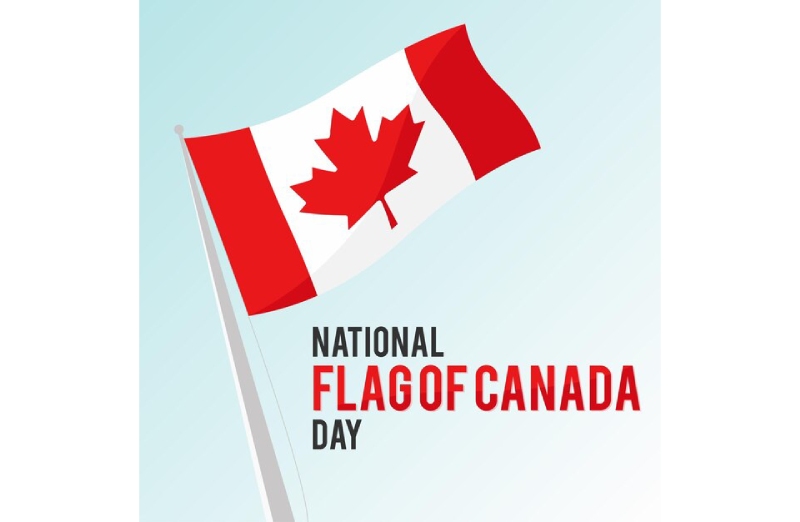
February 15th is National Flag of Canada Day each year. Today is the day that Canada’s current red maple leaf flag was unveiled. The equality, diversity, and inclusiveness that bind all Canadian citizens together are symbolized by the flag. On this day, you may witness people handing out tiny flags in the streets and the Canadian flag flying proudly from building tops. To commemorate this occasion, some people like to wear pins with the flag’s design on them. The significance of the flag and its history are covered in special lessons in many schools. Let’s delve a little further to learn more about this auspicious day.
Every year on February 15, National Flag of Canada Day (French: Jour du drapeau national du Canada), also known as Flag Day, is observed to remember the day in 1965 when the Canadian flag was first flown. In addition to flag flying and sporadic public ceremonies, schools also hold educational events to commemorate the day.
The National Flag of Canada Day commemorates the emblematic symbol that symbolizes the identity and unity of Canadians. In addition to paying tribute to the country’s distinctive heritage, the occasion serves as a reminder to Canadians to preserve national ideals. With its distinctive maple leaf and red and white colors, the Canadian flag is a representation of perseverance, unity, and peace for both its people and the rest of the world.
The current design of Canada Day’s national flag was first unveiled on February 15, 1965, taking the place of the Red Ensign. This is when the celebration’s history began. The idea behind the flag was to create a unique emblem that would represent the country’s pride and sovereignty without having any associations with colonialism. The goal of this important shift was to encourage a deeper sense of patriotism and national unity among Canadians. The Canadian flag, which represents the diverse population’s common values, goals, and contributions to the creation of a prosperous nation, has developed over time into a symbol of identity for the nation.
There are various ways that the National Flag of Canada Day is observed in Canada. Families, groups, schools, and individuals have the chance to celebrate the significance of the Canadian flag by flying it, taking part in educational initiatives, and putting it on display in public areas or on social media. Individuals support one another in participating in pertinent conversations or educational opportunities and in being proud of their national symbol. Every year on February 15th, Canadians celebrate National Flag Day, a significant occasion to honor their flag and the values it represents.
In 1996, Canada held its inaugural National Flag Day celebration. Although the day is not officially recognized by the federal government, each province determines whether or not to observe it as a holiday. Over the years, several bills to make Flag Day a statutory holiday have been submitted to Parliament; however, none of them have been successful.
At the Hull ceremony commemorating the first National Flag of Canada Day in 1996, protests broke out. During one of the protests, Jean Chrétien, who was prime minister at the time, moved through the crowds, grabbed a protestor by the neck, and pushed him aside. This gesture is now referred to in Canada as a Shawinigan handshake since Chrétien is a Shawinigan native. There is even a beer bearing the same name.
Up until 1965, Canada’s official flag was the Royal Union Flag, which is also the flag of the United Kingdom. Between 1868 and 1965, there were several iterations of the Canadian Red Ensign in use, but none of them were officially approved by the Canadian Parliament. The current design of the Canadian National Flag is the outcome of much discussion, debate, and political maneuvering in the early 1960s.
The design involved a large number of people. But Lord Stanley is frequently given incorrect credit as the only creator. Although Stanley played a minor role, John Ross Matheson deserves the most credit for the current design of the flag.
On October 29, 1964, the design was unanimously chosen by the multi-party parliamentary committee tasked with choosing a new flag. On December 15, 1964, the House of Commons approved the design. On January 28, 1965, Queen Elizabeth II announced the adoption of the new flag, which was officially unveiled on February 15 of the same year.
Todd Barrow is rapidly carving out his place in the country music spotlight. Born and… Read More
Bangalore, often dubbed the Silicon Valley of India, is a city that seamlessly blends technological… Read More
Instagram's latest update includes a new feature called "Blend." With the use of this feature,… Read More
Dr. Rema Vassar is a leading advocate for equity in education, particularly in ensuring that… Read More
Exploring the world of guitar music is a journey into the heart of creativity, where… Read More
Marine construction is a vital field that shapes coastal infrastructure, energy production, and global connectivity.… Read More